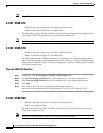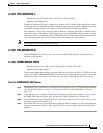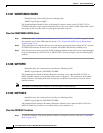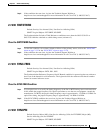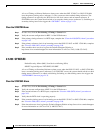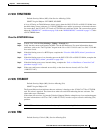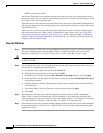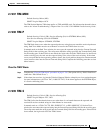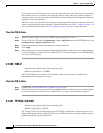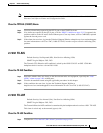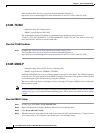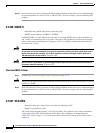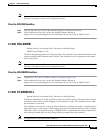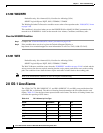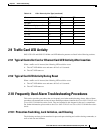
2-140
Cisco ONS 15310-CL and Cisco ONS 15310-MA Troubleshooting Guide, R7.0
Chapter 2 Alarm Troubleshooting
2.7.240 TIM-V
In Auto mode on the receiving port, the card sets the expected string to the value of the received string.
If the alarm occurs on a port that has been operating with no alarms, the circuit path has changed or
someone entered a new incorrect value into the Current Transmit String field. Complete the following
procedure to clear either problem.
TIM-S also occurs on a port that has previously been operating without alarms if someone switches the
cables or optical fibers that connect the ports. If enabled on the port, the “AIS-L” condition on page 2-18
can be raised downstream and the “RFI-L” condition on page 2-118 can be raised upstream.
Clear the TIM-S Alarm
Step 1 Double-click the 15310-CL-CTX or CTX2500 card to display the card view.
Step 2 For the 15310-CL-CTX, click the Maintenance > EC1 > Path Trace tabs; for the CTX2500 card, click
the Maintenance > Optical > Path Trace tabs.
Step 3 In the Expected String column, enter the correct string information.
Step 4 Click Apply.
Step 5 If the alarm does not clear, log into the Technical Support Website at http://www.cisco.com/techsupport
for more information or call Cisco TAC (1-800-553-2447). If the alarm applies to the STSTRM object,
it is Service-Affecting (SA).
2.7.240 TIM-V
Default Severity: Major (MJ), Service-Affecting (SA)
SONET Logical Object: VT-TERM
The VT Path TIM alarm is raised on VT terminations when the J2 path trace is enabled and is
mismatched with the expected trace string.
Clear the TIM-V Alarm
Step 1 Complete the “Clear the TIM Alarm” procedure on page 2-138.
Step 2 If the alarm does not clear, log into the Technical Support Website at http://www.cisco.com/techsupport
for more information or call Cisco TAC (1-800-553-2447) to report a service-affecting problem.
2.7.241 TPTFAIL (CE100T)
Default Severity: Major (MJ), Service-Affecting (SA)
SONET Logical Object: CE100T
The Transport (TPT) Layer Failure alarm for the CE-100T-8 card indicates a break in the end-to-end
Ethernet link integrity feature of the CE-100T-8 cards. TPTFAIL indicates a far-end condition and not a
problem with the port reporting TPTFAIL.



